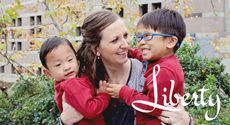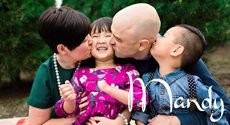Those who have adopted, as well as those currently knee deep in the adoption process, know all about a little thing called waiting. Only it really is not a little thing; it is a big, difficult thing.
The good news is that although the wait is hard, it gives families the opportunity to prepare for their upcoming adoption, so today I would like to share a great checklist designed to help families do just that.
This list outlines important steps, programs, services, and resources available to families built through international adoption.
1. Contact the closest International Adoption Clinic or children’s hospital for a thorough evaluation of the child’s file and a list of specialists relevant to the child’s special needs. (For an informative overview, read The What, Why and How of International Adoption Clinics written by a pediatrician, adoptive mom, and founder of the UAB International Adoption Clinic, Jennifer Chambers.)
2. Make an appointment with the international adoption clinic for a comprehensive exam, evaluation, and testing (as needed) for the child for two to four weeks after arriving home. Ask the international adoption clinic or the hospital’s patient services department if their office has a staff person or social worker that helps families navigate local resources and community service providers.
3. Schedule an appointment with local pediatrician for an initial exam and evaluation of the child. Bring a list of questions with you about local supports he/she would recommend. Ask the pediatrician if their office has a staff person that helps families locate and access resources and services. Also check out the From the Pediatrician:10 Things Parents Should Know written by pediatrician and adoptive mom, D. Youngblood.
4. Connect with one or more of the many online adoption groups as well as groups that are specific to the child’s need(s). There are many groups on Yahoo! Groups and Facebook for adoptive parents and parents of children with special needs – we have a page dedicated to pre-travel adoption specific websites here. An excellent starting place is the Facebook group Special Needs Resources – China Adoption.
5. Look for local adoption-related support groups or mom’s groups to plug into for “real life” friendships and support.
6. Contact your health insurance provider, ask to speak with an advocate or benefits representative, and have a discussion with him/her regarding your insurance plan and coverage. Ask questions regarding the process required to add an adopted child to your plan, when coverage will begin, information on deductibles, copays, and coinsurance, and details regarding specialists and covered services including any exclusions/limitations.
7. Contact your local Early Intervention and/or Intermediate Unit for a thorough in-home evaluation of the services offered by the county/region/state and those for which the child can or will qualify. The Center for Parent Information and Resources website is a great place to start.
8. Contact your local state or county adoption/foster care entity and find out what post-adoptive services they offer and how to access them.
9. Contact your state health department and find out what supplemental services (including potential supplemental insurance) a special needs child may qualify for including requirements and application procedures.
10. Contact an experienced adoptive family to have as a “mentor” for the remainder of the adoption process. Having a mentor who is parenting a child with the same special need can be invaluable. The special need specific groups and the NHBO Mentoring Mom program are both good starting points.
11. Compile a list of supportive family and friends to call when feeling overwhelmed or near crisis. Having a close family member or friend to call when you need to step back and take a break is so important. Actively work to build a support team that you can call upon at a moment’s notice when you are in the trenches.
12. If the child is school age, contact the local school district and begin gathering information regarding enrollment, services, and therapies (including qualification requirements and access information).
13. If there are children already in the family begin preparing them for the adoption and addition of a new sibling. A quick internet search will turn up lots of information, ideas, and resources, but here are a few to get started: Preparing Children for the Adoption of a Sibling, Preparing Big Sister for Our Second Adoption, NHBO Blog Series – Siblings, and if you are a New Mom Through Adoption there is a Facebook group for you.
14. Contact your social worker and home study and placing agencies for additional help navigating any of these resources. Ask what resources they might have experience with and/or knowledge of that might be of additional support.
15. Read! Read everything you can get your hands on that involves adoption including books, blog posts, videos, podcasts, etc. Being prepared for what you may face when meeting your child and during your first hours, weeks, and months together is so important. Learning about attachment and bonding as well as looking at the entire adoption process from the child’s standpoint is also vital and. Here are few suggestions to get you started (and then be sure to head over to the NHBO Before Travel and First Year Home resource pages): The Connected Child, Attaching in Adoption, Dear Parents-To-Be, and the must-read for every adoptive parent, Realistic Expectations.
16. Start now finding and connecting with the local community of your child’s race or ethnic background. This can be done by attending cultural events, learning the language, visiting museums, taking cooking classes, intentionally visiting ethnic restaurants, trying new recipes/foods at home, etc. Find creative ways to build relationships with members of the local community from your child’s cultural background. The more you immerse yourself in your child’s culture of birth, the better prepared you will be to help your child explore and embrace their story. As your child grows in their understanding of their past it is so important that you walk with them by honoring this important part of who they are.
Being well prepared for an adoption is vital and we hope this checklist will help families better prepare for the adoption experience and all that comes with it.
Be sure to check out the newly expanded resource section here on No Hands But Ours.
Special thanks to Tracy Whitney for creating and sharing the original version of this checklist.



























One thing I don’t see that is vital for IA and transracial adoption is growing connections to those of your kids race and culture. Diving in, learning language, food, art, media, what er you can get your hands on. We typically have lots if time between match and meeting our children. Time that can be used to start immersing ourselves in their culture, so we can be prepared to help them embrace it.
Yes, that would be a great addition to the list Lisa!
Good point that could easily be a meaningful addition to #10 or #11 on the list, Lisa! Thanks.
If you have never parented, get some “kid” experience, especially with kids who are not in typical situations. For me, it was 4 years of volunteering in the evening at a children’s hospital. After 8 weeks of training, I was assigned to hematology/oncology, where I spent time with kids who had various cancers, sickle cell crises, and so on. After 6 months, if my primary unit wasn’t busy, I could float to any unit needing help. I changed diapers, cleaned up children wh’d been vomiting, fed infants and toddlers, rocked and walked and sang to non-sleeping babies, helped kids with IV poles navigate to the bathroom, dealt with homesickness and tantrums, played endless games of UNO, and more. Some of the children came from shelters and foster care. Many had low income single Moms. Some had experience with domestic violence. Many were delayed academically because of their illnesses, or simply because they had moved around a lot. Many had learned negative behaviors. Some learned English in the hospital. But all of them responded to love and attention.